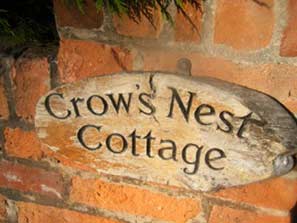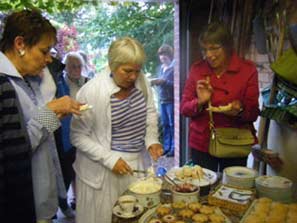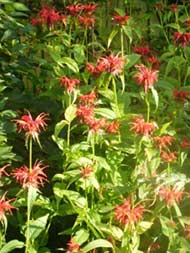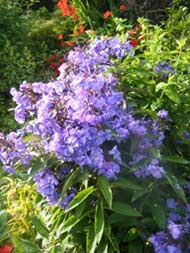The Twilight Garden (28-10-12)
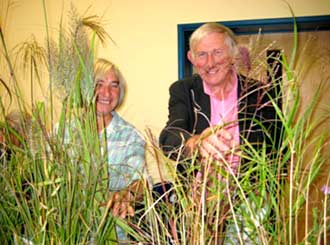 It was in 1985 that Westshores Nursery started, initially specialising in ornamental grasses. Gail (a botanist and part-time lecturer) was joined by John in 1995 when he took over the mail order side of the business as well as grass propagation. In his own words, John has served a 17 year apprenticeship and thinks he's just beginning to get the hang of things.
It was in 1985 that Westshores Nursery started, initially specialising in ornamental grasses. Gail (a botanist and part-time lecturer) was joined by John in 1995 when he took over the mail order side of the business as well as grass propagation. In his own words, John has served a 17 year apprenticeship and thinks he's just beginning to get the hang of things.
Until 2005 the nursery employed two part-time staff who concentrated mainly on bedding plants and hanging basket refilling but this meant all their effort was focussed on a 6 week period of frenetic activity which was then followed by an almost complete cut off of work by mid-July.
One evening in August when Gail was walking home from the nursery, she noticed the effect the decreasing light levels were having on the plants around her. She began to make a mental note of just what was happening and realised that, with some clever attention to planting, you could extend the flowering day and, consequently, the season of interest within your plot.
Gail's first observation was that dark red flowers were the first to disappear in low light levels – so the Bishop of Llandaff dahlias which seemed so rich in sunlight faded away into insignificance in the dusk yet the pale pink of the Japanese anemones reflected what light there was and became positively zingy. Things like bergenia – not exactly a beauty at the best of times – looked quite stunning with the light reflecting from its glossy leaves.
Orange and yellow flowers performed quite well in the gloom though pale lemon stayed the course the longest. But, best of all, were the whites becoming almost phosphorescent in the dark.
Another observation was that some plants displayed magnificent structure in the gloaming: phormiums, euphorbias and echinops each casting a dramatic shadow, as did plants that 'die well' like Echinacea's and grasses and hairy-leaved plants assumed more substance when the light caught the silver filaments on the leaves.
The other element which came to the fore when light was low was scent – we've all experienced the heady perfume of honeysuckle or rose in the twilight and nicotiana and evening primrose are other examples of plants which make their presence felt even when you can't see them.
So, having assembled the players in our garden it was time to hit the stage lights – quite literally! This was the cue for John to dazzle us with his knowledge. He demonstrated the different effects of up-lighters, down-lighters, path/step lighting on various forms of planting incorporating clever coloured jellies to add atmosphere. He also said that we should 'borrow' light from street lights - even light issuing from your own kitchen window can dramatically change your view of the garden. Temporary lights such as Christmas tree lights draped over a tree or shrub created spectacle and even the flash of your car headlights as you travelled up the drive could give a breath-taking display.
It was quite obvious that Gail and John lived and breathed gardening so no wonder they had taken a gold medal at Harrogate in 2010 and gone one better in 2011 gaining the premier award. They certainly gave us plenty to think about and we all went away reflecting on a most illuminating evening.
Margaret Paul
Trentham Gardens (4-10-12)
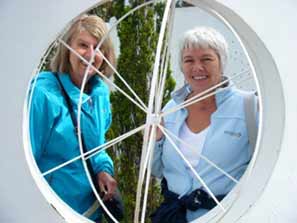 Gardening Club Visit to Trentham Gardens - Sunday 16th September
Gardening Club Visit to Trentham Gardens - Sunday 16th September
If you were expecting Trentham to be an opportunity to have a bit of retail therapy,then you wouldn' t have been disappointed. But if you were expecting a Gardening Experience…. then you would have been delighted! Once past the shops and eateries and through the turnstiles into the 750 acres of the Trentham Estate there was just so much to see and experience. Yes, 750 acres, so where to begin?
 We started by following the sign saying "Get lost this way" and found ourselves in swaying grass and autumn colour in the Rivers of Grass and Floral Labyrinth. Next stopping past the (soon to be turned into a 5* hotel) remains of Trentham Hall to climb the viewing platform to look down on the ornate Italian Garden. Here 70 flower beds designed by Tom Stuart-Smith are designed to show colour and form throughout the year. With stronger colours at the top end ,grading down to more subtle colours close to the lake. Pity Perseus and Medusa were missing - down to London for a few weeks I think.
Then the Show Gardens, the David Austin Rose Gardens and the maze.
We started by following the sign saying "Get lost this way" and found ourselves in swaying grass and autumn colour in the Rivers of Grass and Floral Labyrinth. Next stopping past the (soon to be turned into a 5* hotel) remains of Trentham Hall to climb the viewing platform to look down on the ornate Italian Garden. Here 70 flower beds designed by Tom Stuart-Smith are designed to show colour and form throughout the year. With stronger colours at the top end ,grading down to more subtle colours close to the lake. Pity Perseus and Medusa were missing - down to London for a few weeks I think.
Then the Show Gardens, the David Austin Rose Gardens and the maze.
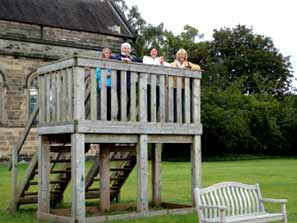 And now for a walk on the wild side. A mile walk along the lake and down to the Monkey Forest where you can get close up to 140 monkeys crashing and chattering through the 60 acre forest. I wonder if any of the Gardening Club swung through the trees in the High Rope Adventure Course? We gave that a miss and made our way back down the lake aboard Miss Elizabeth, cruising along with the herons leading the way.
Time for a late leisurely lunch and yes, a bit of retail therapy in the Shopping Village before leaving for home.
And now for a walk on the wild side. A mile walk along the lake and down to the Monkey Forest where you can get close up to 140 monkeys crashing and chattering through the 60 acre forest. I wonder if any of the Gardening Club swung through the trees in the High Rope Adventure Course? We gave that a miss and made our way back down the lake aboard Miss Elizabeth, cruising along with the herons leading the way.
Time for a late leisurely lunch and yes, a bit of retail therapy in the Shopping Village before leaving for home.
A great day out.
Judy
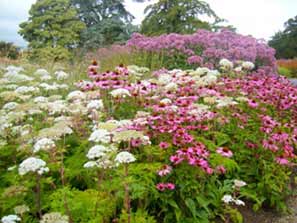
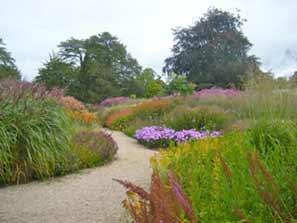
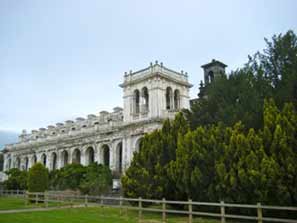
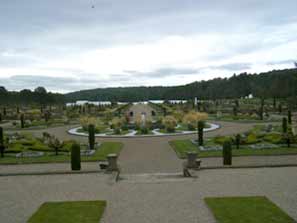


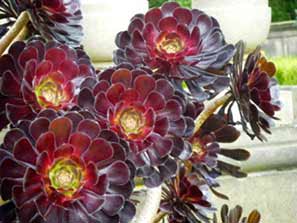

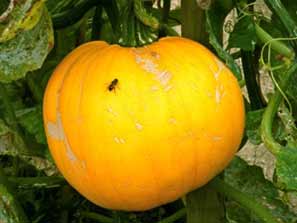
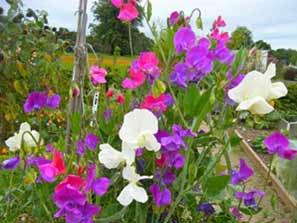
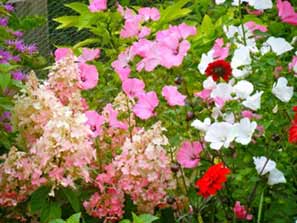
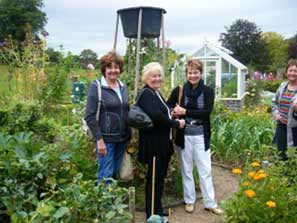
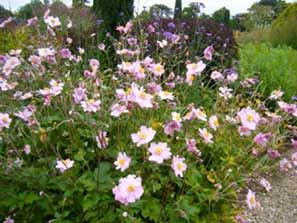
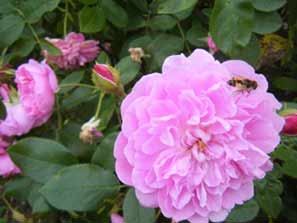


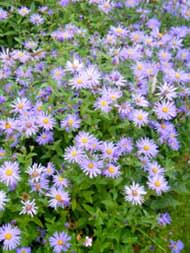
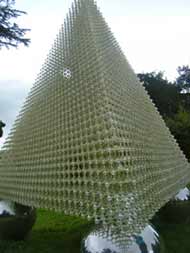
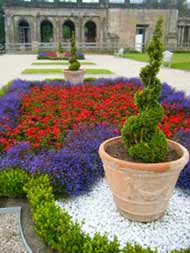
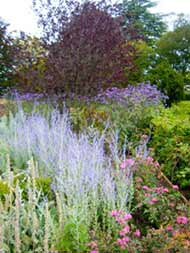
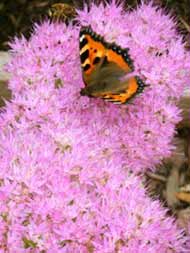
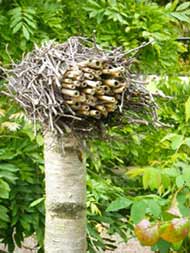
Up the wall and over the garden fence (30-9-12)
- a talk by Anthony Norman on 17th September
 Well, and there's me thinking that the only paints on the climbing plant palette are clematis, honeysuckles and roses when it would appear that almost any plant can be 'encouraged' to climb given appropriate support and a sharp pair of secateurs!
Well, and there's me thinking that the only paints on the climbing plant palette are clematis, honeysuckles and roses when it would appear that almost any plant can be 'encouraged' to climb given appropriate support and a sharp pair of secateurs!
Anthony was keen to inspire us to explore the possibility of offering another dimension in the garden by planting climbers – and not just against walls and fences. Twining climbers through shrubs and trees would extend periods of interest and colour: obelisks planted up at the front of borders would offer a different image and balance to a garden and interest doesn't always mean flowers, it can be seed heads and hips. All that is needed is a proper preparation of site and soil.
 He mentioned the dreaded 'clematis wilt' and ways to prevent it killing off new plants. Always plant 12 – 18 inches away from the support into a hole that is at least 6 inches deeper than the top of its pot. Add general fertiliser to the backfill soil if planted in summer and a top dressing of bone meal in winter and your plant should romp away. If it does succumb to wilt, chop the plant off at ground level and be patient: because you've planted deeply, new growth should appear next spring and the plant will be all the stronger for its ordeal.
He mentioned the dreaded 'clematis wilt' and ways to prevent it killing off new plants. Always plant 12 – 18 inches away from the support into a hole that is at least 6 inches deeper than the top of its pot. Add general fertiliser to the backfill soil if planted in summer and a top dressing of bone meal in winter and your plant should romp away. If it does succumb to wilt, chop the plant off at ground level and be patient: because you've planted deeply, new growth should appear next spring and the plant will be all the stronger for its ordeal.
 Frameworks should be of sufficient strength to support the plant for the duration of its life.
All too often new plants are trained up wispy bits of trellis and become top heavy after a few seasons. Climbers may look thin stemmed but, given time, they can certainly punch above their weight quite literally. Anthony very much favoured the use of thick wire and vine eyes which, when stepped away from fences, can prove durable for many years.
Frameworks should be of sufficient strength to support the plant for the duration of its life.
All too often new plants are trained up wispy bits of trellis and become top heavy after a few seasons. Climbers may look thin stemmed but, given time, they can certainly punch above their weight quite literally. Anthony very much favoured the use of thick wire and vine eyes which, when stepped away from fences, can prove durable for many years.
He was very partial to roses grown for structure but we were warned to differentiate between climbers and ramblers: climbers flower on new season's growth so should be trained to create a framework whereas ramblers flower on previous season's growth so you may need to sacrifice height for width when you are pruning to achieve successive flowering. When pruning you should always remember the 3 Ds – get rid of dead, damaged and diseased material.
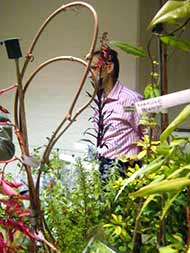 Other plants he suggested which may be used as climbers were: cotoneaster, camellia, garrya elliptica, euonymus, ceanothus, pineapple broom, perennial sweet peas and Rosa glauca which sports fabulous red berries. He also mentioned a fairly new Virginia creeper – Fenway Park – which is one of the yellow forms.
Other plants he suggested which may be used as climbers were: cotoneaster, camellia, garrya elliptica, euonymus, ceanothus, pineapple broom, perennial sweet peas and Rosa glauca which sports fabulous red berries. He also mentioned a fairly new Virginia creeper – Fenway Park – which is one of the yellow forms.
Whatever your requirements, you can be sure there is a plant which can be encouraged to cover an unsightly drain pipe or frame a pretty window and if your passion is for clematis that grow like topsy, just train it round and round an obelisk and you'll get a pyramid of colour from top to bottom.
Margaret Paul
Oxton (27-6-12)
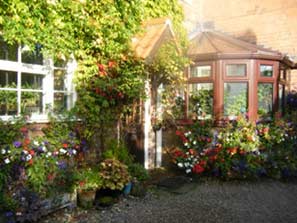 It was an evening of contrasts when we visited two gardens at Oxton. The day had been stormy and wet but the evening was gentle and sparkling. Our party split into two groups to discover the delights the trip was to offer.
It was an evening of contrasts when we visited two gardens at Oxton. The day had been stormy and wet but the evening was gentle and sparkling. Our party split into two groups to discover the delights the trip was to offer.
The garden at Old Manor Farm Cottage was an absolute delight – my kind of garden. Plants and shrubs tumbled over gravel pathways and crawled up walls and over fences and hedges. The lawn was miniscule and the planting lavish though not fancy. Just plain honest-to-goodness plants like bronze-leafed loosestrife, many and various geraniums, oodles of climbers and hordes of creepers and crawlers. Because the property is rented, Pauline is constrained by the rules attached to the tenancy so she can't 'trim' trees or alter fences but the overall effect is English country garden personified and to think she carries out most of the work herself is a testament to her plant husbandry.
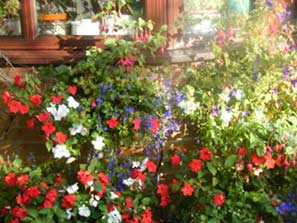 Crow's Nest Cottage was a different kettle of fish entirely and is gardened by Joan supported by Tom (who provides some of the muscle). In front of the house was the most amazing display of hostas – and not a chew mark anywhere in sight. How did she do that? Continuing along the front was a deep border of rhododendrons, azaleas and other shrubs edged by a froth of London Pride. To the side of the house there was a large tear-drop shaped island border which was stuffed with all sorts of scented plants. Further still and the garden opened into a large area of lawn, trees and shrubs. Here were the wildlife ponds and streams that the garden is renowned for. Height had been added to the corner of the garden by shifting the excavated soil from the pond right to the edge of the boundary. Beautiful planting surrounded the main pool with specimens of year-round interest, and the small waterfall was studded with geckos and dragons and tiny pergolas.
Crow's Nest Cottage was a different kettle of fish entirely and is gardened by Joan supported by Tom (who provides some of the muscle). In front of the house was the most amazing display of hostas – and not a chew mark anywhere in sight. How did she do that? Continuing along the front was a deep border of rhododendrons, azaleas and other shrubs edged by a froth of London Pride. To the side of the house there was a large tear-drop shaped island border which was stuffed with all sorts of scented plants. Further still and the garden opened into a large area of lawn, trees and shrubs. Here were the wildlife ponds and streams that the garden is renowned for. Height had been added to the corner of the garden by shifting the excavated soil from the pond right to the edge of the boundary. Beautiful planting surrounded the main pool with specimens of year-round interest, and the small waterfall was studded with geckos and dragons and tiny pergolas.
So, having feasted our eyes on the splendours of the garden it was time to console the inner man and partake of the beautiful spread laid on by Joan. There really is only one place to fully enjoy an English scone and cream and Crow's Nest provided the very place.
Margaret Paul
